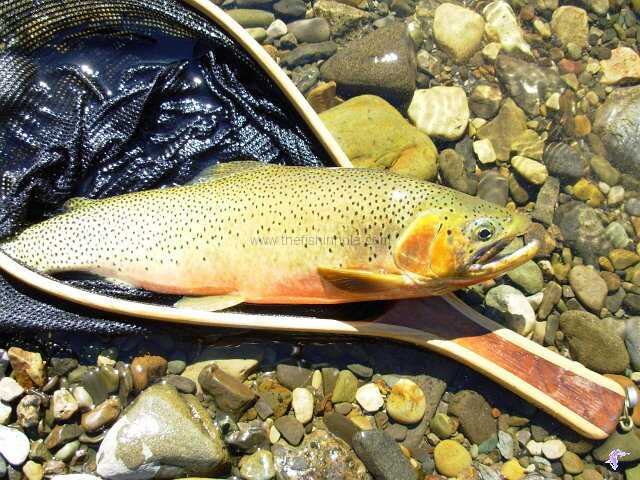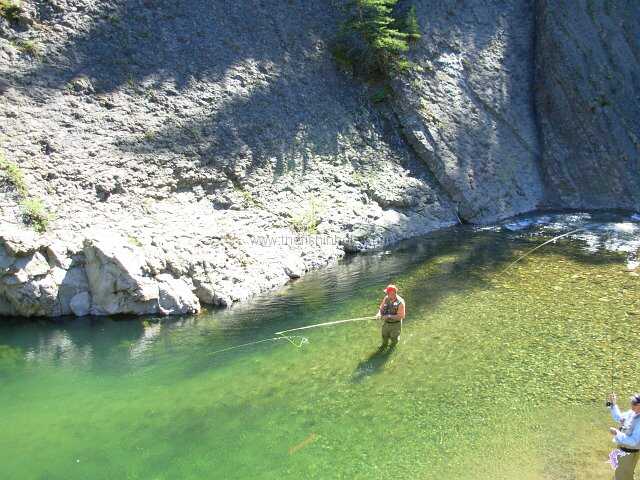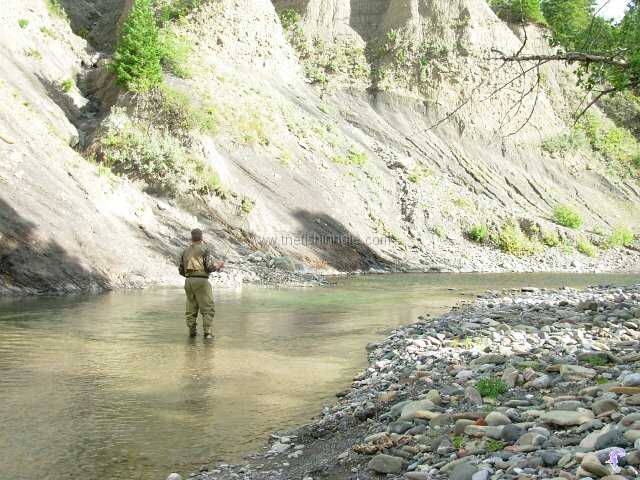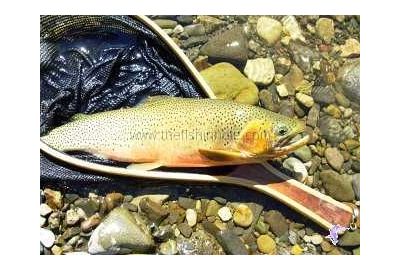If there's a more perfect angler's fish than the cutthroat trout, I've yet to learn of it. It's undeniably beautiful, with its distinctive spots of black peppered against a multi-hued backdrop of green, orange rose, yellow and gold. Additionally, there are the trademark orange-red slashes along the throat that give the cutthroat its name. It's not just the fish itself that's beautiful, however; the places they call home are generally nothing short of spectacular. The cutthroat demands cold, clear waters, meaning they live in relatively remote, high altitude streams that invariably are nestled within or abutting harsh mountain or foothills wilderness. Last, though anything but least, cutthroat are the easiest of our true trout to catch. Their relatively sterile home waters mean that available food is at a premium and, as a result, a cutthroat will take a run at just about anything looking even remotely edible that drifts by. Further, given that they most often inhabit fast water, cutts don't have much time to be selective about what they'll take, most often charging a fly or spinner as soon as it comes into sight. So, what's not to like when you have a gorgeous fish living in awe-inspiring places that is eager to eat just about anything you offer it?


Those who nitpick will suggest that the cutthroat isn't a great fighting fish, and while it's true that they don't perform the aerial acrobatics of their rainbow cousin, preferring instead to battle you down deep, a cutthroat taken on light tackle is capable of providing a worthy tussle; I can all but assure you that you won't land every one that you hook.
Cutthroat trout in Alberta are native to the Oldman and Bow River drainages, though historic stockings have resulted in sustainable populations in other river systems, as well as, in some high mountain lakes. The most popular watershed among cutthroat enthusiasts is the Oldman, where cutts are found in just about every stream and creek above the dam. Favourite waters include: the upper stretches of the Oldman main stem itself; the Livingstone River and its tributaries, especially Dutch and Racehorse Creeks; the Carbondale River and tributaries Lost and Lynx Creek; and, the Castle River system, including the West Castle and South Castle tributaries and their feeder streams. For those so inclined, there's also some superb cutthroat fishing available just over the border into B.C. through the Crowsnest Pass. The most renowned of these waters, and deservedly so, is the Elk River. This is quite possibly the best cutthroat stream in Canada, offering numerous access points and harbouring lots of fish, including no shortage of 16" plus cutts. Other popular waters in the area that are definitely worth a visit include the St. Mary River, the Wigwam River, and tributaries of the Elk River including the Fording River and Michel Creek.


Looking back to Alberta, there are knowledgeable anglers who swear that the best cutthroat fishing in the Wild Rose Province is found in the North Saskatchewan River watershed, namely in rivers such as the North and South Ram, the Blackstone, the Cardinal and their numerous tributaries. Many of these waters were stocked in the 1950s and 60s, and there is no denying their productivity for cutts today. Fishermen and biologists with foresight pushed for protective legislation for the North and South Ram, and these are often the waters of choice for anglers who seek trophy-sized fish. If you're so inclined, these rivers hold enough honest 20" - 24" cutts to make the required patience and persistence worth the effort. At the other end of the spectrum, for those seeking sheer numbers of fish, it's awfully difficult to beat the Ram tributaries like Hummingbird Creek, Onion Creek and others. While the eager trout in these small, clear waters are pretty much exclusively less than a foot in length, you can literally fool as many of them as you care to.
If you prefer to fish lakes for cutthroat your options are limited. The best waters are found in Kananaskis Country, particularly Rawson, Rummell and Stenton Lakes, which are all actively managed with an eye to establishing trophy waters.
For those with limited experience on flowing waters, reading rivers and streams can be an intimidating and bewildering proposition. One of the positive spinoffs of the cutthroat's need for cold, clear, well-oxygenated waters is that most of these streams are relatively small. On the vast majority of cutthroat streams you can cast all the way across with a single cast and I can only think of a couple instances where two casts wouldn't do the trick. This makes reading the water easier than it is on larger rivers such as the Bow, lower Oldman, Red Deer, North Saskatchewan and the like. When you first approach a cutthroat stream, stand and watch it for 10 or 15 minutes. Often you'll discover cutts rising and there is no better way to understand where trout live than to learn firsthand from the fish themselves. There are times, of course, when the fish aren't rising, when understanding fish holding and feeding behaviours becomes important. In general, look for fish to be laying where they can escape from the strongest flows of the river. This is often below undercut banks, behind rocks and boulders along the bank or on the stream bottom, and behind logjams.


Other productive locations include current seams, eddies, pools, pockets, riffles and runs. If this reads like a laundry list of flyfishing mumbo-jumbo, don't worry. Look for pools of deep, slower water often found at corners and below ledges. Start fishing from the lower lip of the pool up towards the top edge and you are going to catch fish. It is important to fish upstream on these small waters, remembering that fish will also be facing upstream. Angling from above can easily spook fish and put them down. As the summer progresses and the waters warm, cutthroat will congregate in the pools and in rapids or riffles, locations where they can find cooler and more highly oxygenated water.
Cutthroats are ideal fish for the seasoned and novice angler alike. You can walk and wade most cutthroat streams with little difficulty, meaning gear requirements are pretty basic. Further, they're found in streams that generally offer lots of nearby opportunity for family camping and are willing enough combatants to make ideal adversaries for any "occasional" fisherman or for the beginning fly angler in the family. Remember, however, that the cutthroat's very eagerness that makes them such a wonderful fish to pursue also renders them vulnerable to overharvesting and other unscrupulous or careless fishing tactics. If we follow the regulations, treat fish carefully when handling and releasing we can depend on the cutthroat continuing to be the angler's trout for generations to come.


